The 65 goals they scored were fourth-best in Major League Soccer. The 40 times they conceded made them the league’s third-stingiest defense, aligning nicely with a 62-point haul that left them third in the final Supporters’ Shield standings. There may be no single part of Sporting Kansas City’s resume that screams greatness, but in their lack of weaknesses – the lack of areas in which Peter Vermes’ team were even average, this season – you’re forced to reconsider.
Sporting has three players who scored at least 10 goals this season, and another two whose goal totals prorate to double digits over 34 games. They have two former Defenders of the Year in central defense, a recent Goalkeeper of the Year in goal, and a midfield three made up entirely of players who competed or trained at the highest levels of European league soccer. The West’s first-place finisher also has a U.S. international at right back and a veteran with over 200 MLS appearances on the opposite flank. Sporting may not possess any true MVP candidates, this season, and their star defenders may have performed just outside the core Defender of the Year discussion, but throughout their lineup, Kansas City profiles as a team without an obvious flaw.
That doesn’t mean there won’t be spaces for the Portland Timbers to attack beginning this weekend, when the teams start their Audi 2018 MLS Playoffs Western Conference Championship series on Sunday (4:30pm PT, FS1 | Presented by Oregon Lottery). As with any other team, how Sporting chooses to play gives up as much as it secures. But in the high floor their talents bring to each match, the two-time MLS champions offer few ways they’ll beat themselves.
Portland discovered as much in 2015, when it took penalty kicks to leave Sporting defeated at Providence Park in the Knockout Round. It took an 88th-minute winner the next year for Seattle Sounders FC to oust the 2013 champions, while the Houston Dynamo needed extra time to send SKC home last season. The fact that Sporting, before this season, hadn’t won a playoff game since their title run was cited before and during the team’s conference semifinal ouster of rival Real Salt Lake, but few mentioned that, amid three one-goal losses and a draw, Sporting was always an excruciatingly tough out.
Go level by level on the field – look at the team’s approach as much as their personnel – and you can see why. Kansas City employs a style that’s predicted not only on where and how, on the field, they prefer the move the ball, but endemic to their style is a belief that in their work rate, in their ability to out-battle you for contested balls, their ethos becomes an advantage.
Sporting KC’s attack versus Portland’s defense
Three players along the width of SKC’s attack will ensure every part of the Timbers’ defense line is always in question, with left wing Dániel Sallói and right wing Johnny Russell as committed to staying wide as any pairing in the league. In contrast, Sporting’s striker – usually Diego Rubio, but because of the Chilean’s yellow-card accumulation suspension, likely to be Khiry Shelton, on Sunday – will pop up throughout the attack, venturing left to combine with Sallói, ...
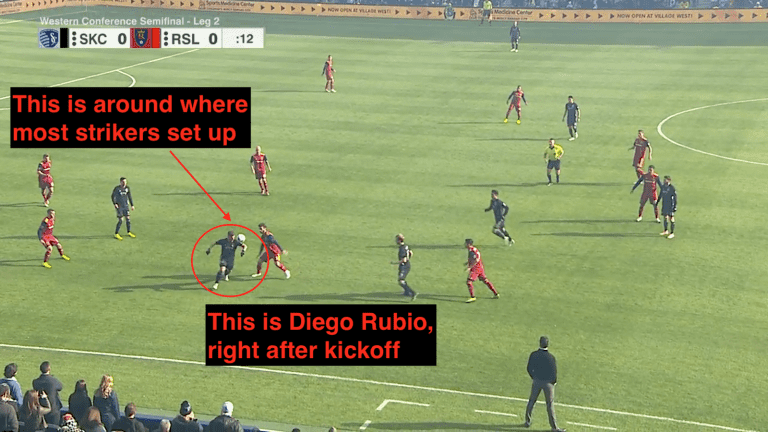
... or dropping into midfield to offer a passing outlet for Sporting’s back five (more on this, below).
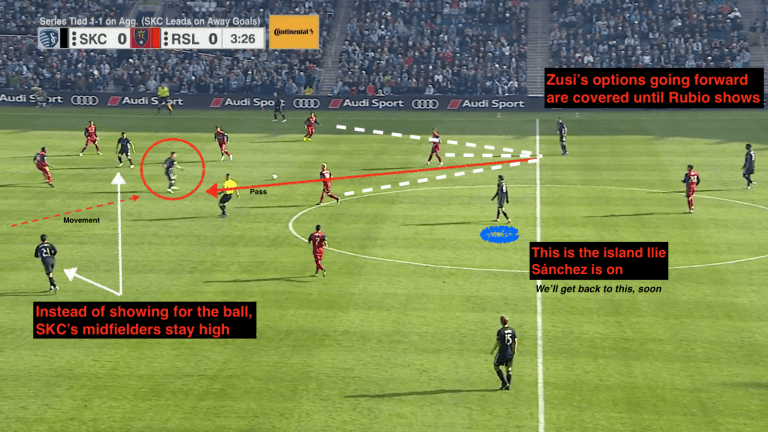
Even in those cases, though, highest midfielder Felipe Gutierrez will often take up the striker’s position, keeping the opposing center backs occupied.
Functionally, that means the opposing defenders can’t play as close together, across the width of the field, as they might against most teams, leaving more space for attackers through the middle of the park. When Sporting can win battles on the flanks, passes played back toward the middle see the likes of Rubio/Shelton, Gutierrez, the opposite winger and, often, midfielder Roger Espinoza (three goals, nine assists) attacking more space between opposing center backs’ channels.
On an individual level, the greatest threat here is to Portland’s left back, though it’s not the only place where Sporting can be dangerous. But the speed and industriousness of Russell, whose MLS debut yielded a 10-goal, 10-assist season for the 28-year-old Scot, are aspects to which defenders must physically respond. Scheme around it all you want, but for opposing coaches, they have to accept there will be points your left back will have to prove capable of slowing down, if not outright stopping, Sporting’s most reliable one-on-one option.
That’s not to say Sallói, on the other flank, can be ignored. His 13 goals in 31 games (regular season and playoffs) would have led the Timbers, too. Rubio averaged a goal every 88 minutes, this season, and while that insanely low rate won’t be an issue on Sunday in Goose Hollow, Sporting will still have multiple above-average goalscoring options without the 25-year-old on the field.
Portland |
Minutes |
Goals |
Goals/90 |
Sporting |
Minutes |
Goals |
Goals/90 |
|---|---|---|---|---|---|---|---|
Armenteros, Samuel |
1590 |
8 |
0.452 |
Rubio, Diego |
879 |
10 |
1.024 |
Ebobisse, Jeremy |
698 |
3 |
0.387 |
Sallói, Dániel |
2464 |
13 |
0.475 |
Blanco, Sebastián |
2864 |
12 |
0.377 |
Russell, Johnny |
2350 |
10 |
0.383 |
Valeri, Diego |
3038 |
12 |
0.355 |
Gutiérrez, Felipe |
1702 |
7 |
0.370 |
Guzmán, David |
1109 |
3 |
0.243 |
Fernandes, Gerso |
1598 |
5 |
0.282 |
For the Timbers’ defense, this is a drastically different challenge to Seattle’s. The Sounders had one main goalscorer, meaning centerbacks Larrys Mabiala and Liam Ridgewell could make Raúl Ruidíaz a disproportionate part of their focus. Seattle’s wide players (Víctor Rodríguez and Cristian Roldan) were bigger parts of the team’s possession and buildup, lesser parts of the team’s goalscoring. And while Nicolás Lodeiro and SKC’s Gutierrez may be equally important to their respective teams, in their movements and areas where they have the most impact, they have important, often drastic differences.
Sporting’s is a deep, talented group helped by a style of playing which, consistent in its implementation and execution, allowed almost all of its attackers to produce near the high end of their potentials. But the main way they exert their danger often has much to do with what’s happening behind them as what’s going on along the opponent’s line.
Portland’s midfield versus Sporting’s midfield
There, SKC features midfield three that is one of the most balanced in the league, with Espinoza’s versatility and intelligence forming a pivot point that allows Gutierrez and Ilie Sánchez to work.
As SKC builds play, Sánchez is given license to follow the ball, a luxury you want you best distributor to enjoy, But that freedom is made possible by Espinoza, who drops in to make sure his team isn’t committing too much to one phase of the game. In this way, the former Wigan Athletic midfielder often plays a vital role without putting in a touch. Likewise, whether Gutierrez wants to play close to the opposition’s defense or drop deeper in midfield, Espinoza is the player who will take up the vacated space, making sure his team’s shape maintains its equilibrium.
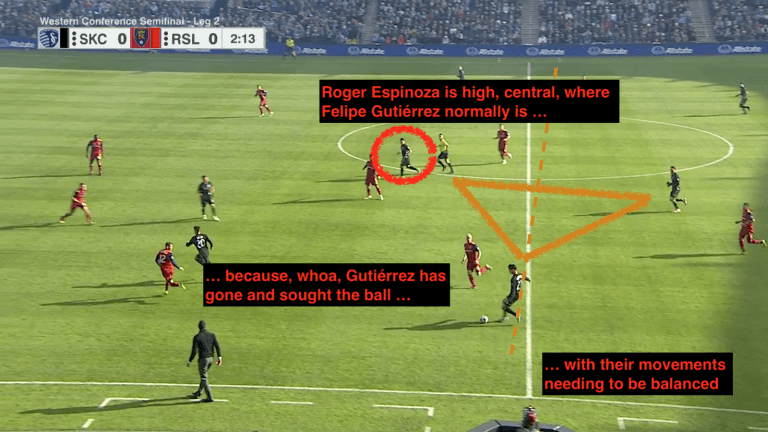
Every team, in their own way, tries to strike this same balance, but the way Sporting keeps theirs is different from any team in the league. Often leaving huge spaces between their highest five (the forwards, plus Gutierrez and Espinoza) and the back five (the defense, plus Sánchez), SKC is willing to play with what some call a broken formation – the shape that, on the surface, doesn’t seem to connect its parts through the length of its setup. The main symptom of this: leaving Sánchez alone to build play out of the defense; seeming only offering a second midfielder as help when other solutions have failed.
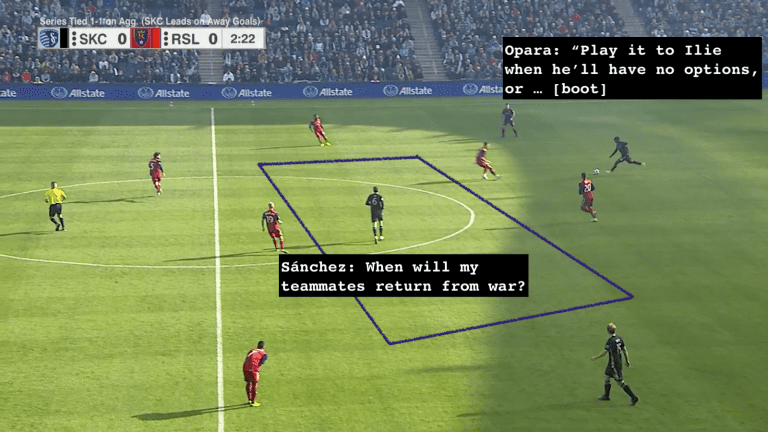
What are those solutions? Sporting’s familiarity with their system means they’re always capable of finding new solutions, but when you look back at their last game against Real Salt Lake (which, in fairness, is not enough film to rely on), you see three general things that jump out.
First, if you play off their back five and give them space to operate, they’re more than willing to use it, be it with somebody carrying the ball forward until they’re engaged or by dropping players like Rubio/Shelton, Russell or Gutierrez into gaps a defense leaves in their formation.
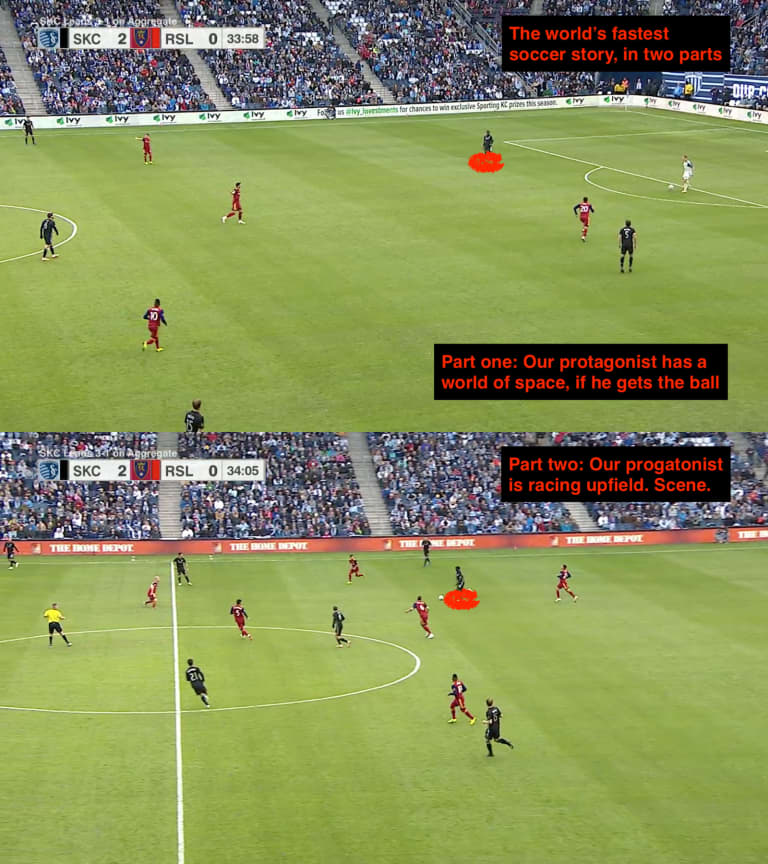
The obvious answers, here, for a defense are to be aware of the passing lanes, make the right reads in midfield, and use SKC’s attempts to break lines as an invitation counter attack. Even one or two unrealized threats from contested balls could force Sánchez and Co. to reconsider their decisions, particularly when Graham Zusi and Seth Sinovic’s want to get forward leaves the team’s center backs exposed.
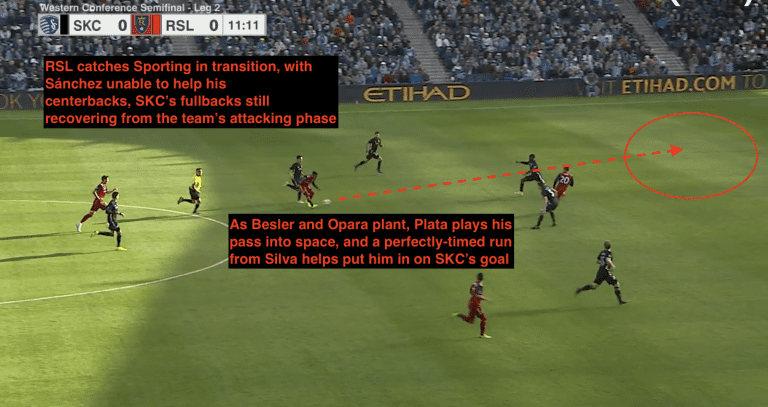
Second, instead of automatically dropping Espinoza or Gutierrez to give Sánchez options, Sporting will instead employ a move which, over the last four years, has become relatively common in world soccer – one that explains why Zusi, the team’s right back, leads MLS in touches.
Player |
Team |
Games Played |
Minutes Played |
Touches |
Touches/90 |
|---|---|---|---|---|---|
Zusi, Graham |
Sporting KC |
36 |
3240 |
3151 |
87.5 |
Bradley, Michael |
Toronto FC |
32 |
2857 |
2982 |
93.9 |
Moralez, Maxi |
New York City FC |
35 |
3088 |
2943 |
85.8 |
Sánchez, Ilie |
Sporting KC |
36 |
3240 |
2927 |
81.3 |
Lodeiro, Nicolás |
Seattle Sounders |
29 |
2638 |
2820 |
96.2 |
A former midfielder, Zusi can also change games distributing from a central role, which explains why, in Sporting’s buildup and attacking phases, he will come in from his wide position and provide an outlet for Sánchez.
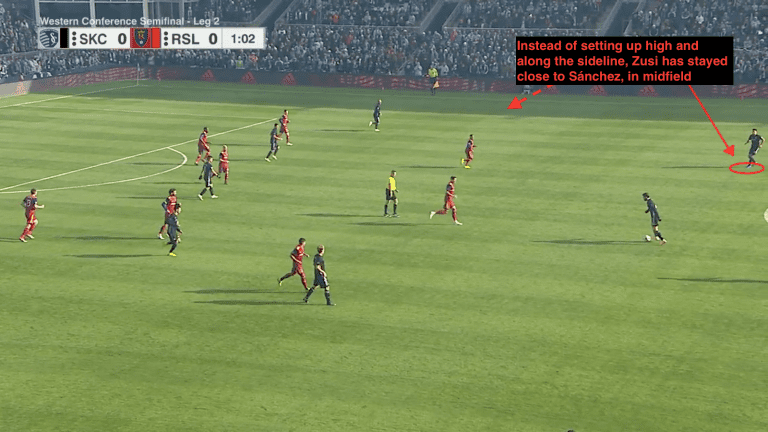
Portland has done this, too, this year, most notably when Zarek Valentin was the team’s starting left back. But whereas, for the Timbers, the tactic is a club in their bag – and usually only used it once the team is through their buildup phase – Sporting has made this a part of their identity. They can define themselves as a relentless, pressing team partly because they can keep Espinoza and Gutierrez high, have them in positions to pressure and rely on Zusi to play a disproportionate part in the buildup. Plus, when the combinations between Zusi, Sánchez, Russell and Rubio are clicking down SKC’s right, Sporting has a way to utilize their most reliable option.
Finally, Sporting is not afraid to just boot the ball, something that’s less a pejorative than it sounds. Giving the ball away and playing for territory is just a reality in a soccer culture where the college system pumps high-level athletes out at a brain-bending rate. As so many have rightly noted, that culture isn’t doing enough to pair those athletes with commensurate technical quality, but when you’re in a league where opponents can use speed, strength, endurance and willingness to press the hell out of you at any moment (and, have recruited from the outside to complement those characteristics), you have to be willing to boot the ball.
Whereas once Sporting was known for their willingness to play long, now, they’re not among the league’s most prolific long ball purveyors.
Passes/Game |
Short Passes/Game |
Long Passes/Game |
% of Passes Short |
% of Passes Long |
|
|---|---|---|---|---|---|
Statistic |
509.3 |
443.8 |
65.5 |
12.9 |
87.1 |
Rank |
3rd |
3rd |
7th |
19th |
5th |
This is why, when watching Sporting KC, it can be difficult to explain their possession numbers. They don’t play like Barcelona, or Manchester City, or other teams whose rapid ball movement and manipulation of space makes their monopolization of play explicable. Sporting doesn’t do that. Instead, there is a patience to their play which, combined with their willingness to fight for second balls, keeps them in control. Still, the same approach that emerged in 2009, when SKC acquired targetman Kei Kamara from Houston and installed him at left wing, has persisted to this day. Sallói, trained as and with the size of a striker (six-foot-one) is often matched up against smaller, less aerially capable fullbacks, allowing Sánchez and Sporting’s defenders to target him when other buildup options fail. The times that possession moves to Zusi and Opara on the right of SKC’s line, players like Gutierrez and Sinovic know the ball is likely to target Sallói. The resulting headers often see Sporting, having anticipated the play, with a man up in the battle to win the second ball.
It’s another example of where Kansas City, instead of creating opportunities for you, will force you to beat them heads up.
Portland’s attack versus Sporting’s defense
This is where that “heads up” can turn in the Timbers’ favor, because when you look at Portland’s talents, you see a slew of potential opportunities for those moments the Timbers can gain control.
On the right flank, Andy Polo’s pace will give Sinovic problems, should Polo play. Like first-choice left back Jorge Villafaña, the Peruvian international is coming off commitments for his country. His fitness will have to be assessed when he returns. Whether he or Dairon Asprilla starts at right wing, though, SKC’s 31-year-old defender will struggle to keep up, and although both Polo and Asprilla have struggled to be goal dangerous on the ball, the mere turning of a defense that’s often waiting for Espinoza and Gutierrez to recover could be significant, on its own.
Further in,
Diego Valeri
could have a lot of space to explore, because even when Sánchez is back in his defensive midfield hole, Sporting’s want to keep five high – and the decisions their defensive midfielder has to make to compensate – leaves the FC Barcelona product conceding space in order to confront the ball. When the Valeris or
Sebastián Blancos
of the world can get to those spots, it requires quick decisions from Matt Besler and Ike Opara, who either have to stop the next ball or see the space they’ve abandoned invaded by an attack’s other options.

One of those options will be Jeremy Ebobisse, who, from his striker’s position, is also capable of exploiting Sánchez’ abandoned space, with the 21-year-old’s ability to distribute from between lines potentially making the most of the channels alongside Besler and Opara. Ebobisse works as an avenue to getting Polo/Asprilla behind Sinovic, with play behind Sporting’s left back potentially allowing “Jebo,” Valeri and Blanco to attack balls fired back into the box. In general, with the lack of support in front of them, Besler and Opara’s management of Ebobisse becomes a greater challenge, with Ebobisse’s skill and movement putting so much pressure on a duo that’s already asked to do so much.
The Timbers’ most important attacker, though, may prove to be Blanco, and for reasons that extend far beyond what he will contribute going forward. To this point in the postseason, “Chucky’s” defensive contributions have gone largely unnoticed, but frequently having to drop deep to help clean up play as teams cross from the other half of the field, Blanco’s effort has been as notable as any other Timbers’ through the first three matches of the playoffs.
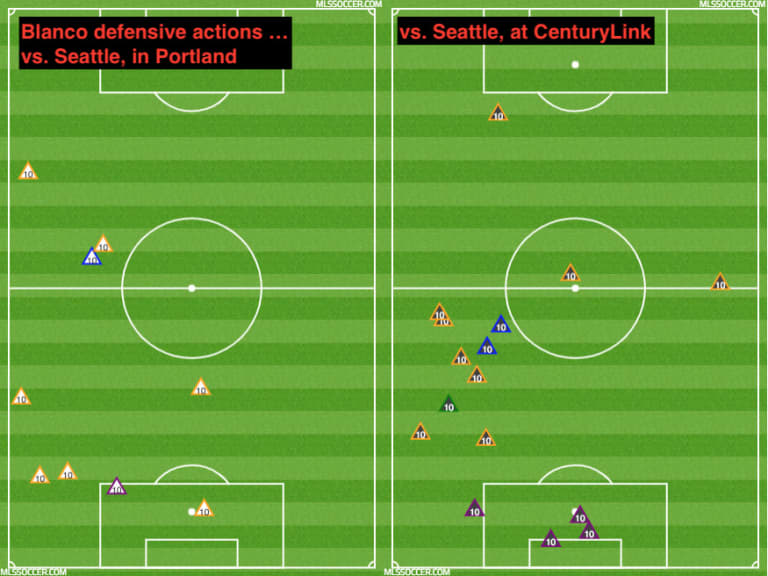
Against Sporting, that effort will be needed even more than before, with SKC’s ability to use Russell and Zusi so crucial to their buildup options. Just as he was asked to do against Dallas and Seattle, Blanco will be tasked with evening the numbers in front of the team’s left back, and although Portland is unlikely to see as many crosses as they faced against Seattle, Blanco’s willingness to clear play at the left edge of the Timbers’ penalty area will be key to relieving pressure.
At the other end of the field, however, Blanco could have a game-breaking presence, partially because his best traits targets so many of the weaknesses Sporting offers. That space behind Sánchez that tends to open up? Blanco has often been most effective, this season, utilizing that part of the field. When Ebobisse comes into that area, it’s Blanco that’s most likely to be the player charging through channels, onto through balls. And the tough decisions Besler and Opara are so often tasked with making? Blanco will be forcing those choices, with his movement across the defense’s face (as evidenced by his goal in Seattle) not only forcing the center backs to account for him but also creating options for Ebobisse to explore.
In that way, the two challenges facing Portland and Sporting’s defenses are, at their core, similar. But whereas Sporting stretching defenses creates questions for their opponents, it’s their willingness to be stretched, in a different way, and rely on their center backs that asks questions of themselves. While Portland has two midfielders (Diego Chara and David Guzmán) offering their back line support, Sporting may be subject to how often Valeri, Blanco and Ebobisse have the ball, and how often they can execute.











